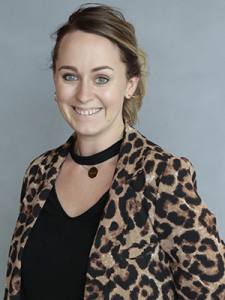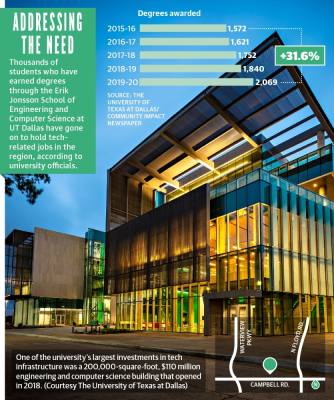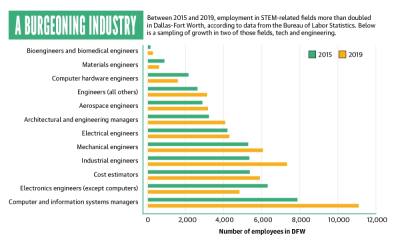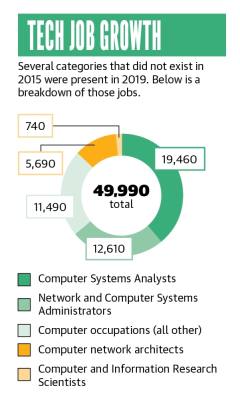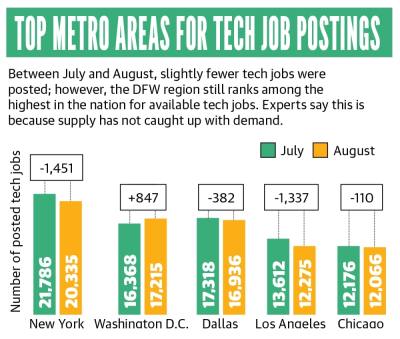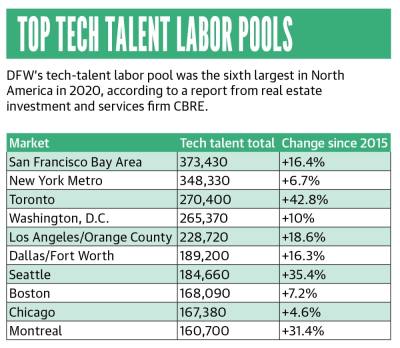Dallas-Fort Worth’s tech talent labor pool was the sixth largest in North America in 2020 with 189,200 workers, up 16.3% since 2015, according to a July report from commercial real estate services and investment firm CBRE. Despite a seemingly healthy pipeline, industry leaders say supply has not caught up with demand.
According to a monthly analysis by The Computing Technology Industry Association, the Dallas metropolitan area had 16,936 tech jobs available in August—the third-highest number of postings in the U.S.
“That kind of demand [creates] a lot of difficulty [in] getting supply and is causing a lot of wage inflation,” said Bill Sproull, president and CEO of the Richardson Chamber of Commerce. “You don’t just mint an engineer or a computer scientist overnight. It takes a while to get a degree in those fields.”
Thousands of students were enrolled in UT Dallas’ Erik Jonsson School of Engineering and Computer Science in fall 2020. The vast majority are pursuing a bachelor’s degree in computer science, a degree path that has seen enrollment grow by just shy of 467% over the past decade, according to data from the university.
Other majors offered in the school include mechanical engineering, electrical engineering, biomedical engineering, computer engineering and software engineering.
The average tech salary in the Dallas-Fort Worth region in 2019 was just over $95,000, a nearly 6% annual increase, according to a 2021 Tech Salary Report from Dice, a marketplace for technologists that helps professionals manage their careers and employers connect with highly skilled tech talent.
“When you look at the tech industries overall, what we have done is flex ... our ability to prepare our workforce moving forward,” said Calvin Jamison, UT Dallas’ vice president for facilities and economic development. “We have the infrastructure, and then we also have the pipeline.”
Addressing the need
In response to North Texas’ burgeoning tech industry, UT Dallas has invested millions of dollars in related infrastructure. In 2018, the university opened a 200,000-square-foot, state-of-the-art engineering and computer science building that cost $110 million.
The university has also doubled down on its investment in research, Jamison said. That is a big draw for companies looking to relocate to the Dallas area, he said.
“Because we are engaged in undergraduate research, our students can transition and go into the work environment and continue that research,” he said.
Several local companies have tapped into UT Dallas’ talent pool by offering student internships. Since 2016, students interested in cybersecurity and software development have had the option of interning with State Farm’s Information Technology Department. The program has historically accepted 12-18 UT Dallas students per semester, said Amanda Morgan, a technology analyst on State Farm’s workforce team who is responsible for recruiting student interns.
The State Farm Internship Program involves honing technical skills, but it also focuses on the development of soft skills. Students learn how to work on a team, how to adapt to changing scenarios, and how to communicate with leadership, Morgan said.
“We are looking to build our future leaders,” Morgan said, noting that the intern to full-time employee conversion rate for the UT Dallas program is about 90%. “I can’t tell you how many executives, directors, managers and senior-level engineers have been through our intern program.”
Strength in numbers
One of the ways UT Dallas acts as an “economic engine for the region,” Jamison said, is through its partnerships with regional industry leaders. A prime example of this is the UTDesign program, which pairs regional companies with senior engineering and computer science students to solve real-world engineering problems.
Since 2014, more than 4,200 students in the UTDesign program have worked with 364 companies on 834 projects, nine of which have won national first place awards, according to UT Dallas.
One of the biggest advantages for the program’s corporate partners is the potential for recruitment, said Robert Hart, a director of the program who is also a clinical associate professor of mechanical engineering.
“They get an eight-month-long job interview with six students,” Hart said. “They really get to see how students perform in all kinds of situations, and that’s a lot better than a two-hour job interview on some random day of the week.”
For their UTDesign project, Trent Sakakini’s team designed a product for UT-Dallas spinoff company Adaptive3D. The assignment was to design a sorting machine for the company’s 3D-printed nasal swabs.
“Nobody ever told us what to do—there were no guidelines,” he said. “They said, ‘Here’s what we need. You guys figure it out.’”
Adaptive3D President and CEO Walter Voit is also an alumnus and associate professor of materials science and engineering at UT Dallas. He said partnering with UTDesign is a cost-effective way to gain fresh perspectives on open-ended problems that lack specific solutions.
“Not only does it help us accomplish near-term needs in design and innovation, but it also provides a robust recruiting pipeline to allow students to get to know us as a company,” he said. “Students get a chance to work with us, and be a part of our culture and our vision, and buy into how we see the world.”
The product Sakakini’s team designed for Adaptive3D went on to win second place in the American Society of Mechanical Engineers’ Student Manufacturing Design Competition.
This real-world experience, combined with other internships, clubs and courses he has been a part of through UT Dallas, has given Sakakini the confidence and skills to enter the workforce after college, he said.
“Having all of these opportunities helped me to develop myself as an engineer as well as a person,” he said. “I’ve had experience, I’ve had a lot of practice—I’m ready to go.”
The road ahead
Another valuable partnership is the one the university has with the city of Richardson, Jamison said.
UT Dallas recently announced it will open five new research centers as well as an extension of its Venture Development Center within the city’s newly minted Innovation Quarter, a 1,200-acre industrial area east of Central Expressway that Richardson officials plan to transform into “the premier tech hub in Texas.”
This partnership will “help cultivate the next generation of entrepreneurs,” said Joseph Pancrazio, UT Dallas vice president for research, said in a previous interview with Community Impact Newspaper.
Ensuring a healthy pipeline of talent for the region’s tech industry requires sparking an early interest in science, technology, engineering and math, said Tad McIntosh, president and CEO of Dallas-based HumCap Recruiting.
“We have a really big issue with STEM talent, so the best thing we can do is continue to encourage math and sciences younger and younger to keep up as a local market,” he said.
In 2018, Richardson ISD launched its Future Ready: STEM for All initiative, which aims to provide access to STEM education for all students through problem-based learning, career and technical education, electives, competitions, clubs and more.
The introduction of STEM concepts in RISD happens as early as elementary school, said Kyndra Johnson, executive director of STEM and innovation with RISD. The district is also beginning to offer STEM clubs to elementary-age students.
“We [believe in] crayons to college to careers,” Johnson said. “We begin with our smallest, most curious individuals, and we build their capacity as they move through our district so that when they get to high school they will know what cybersecurity or biotechnology is, and they can enroll in those areas and hopefully pursue STEM majors when they leave us.”


